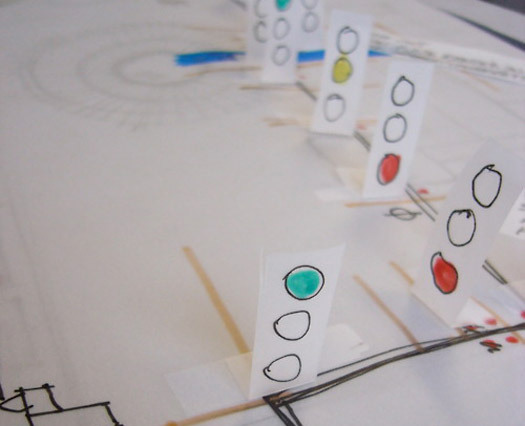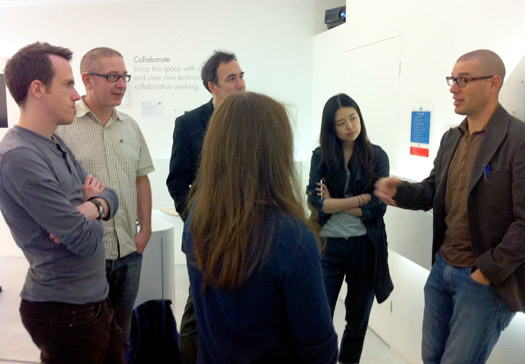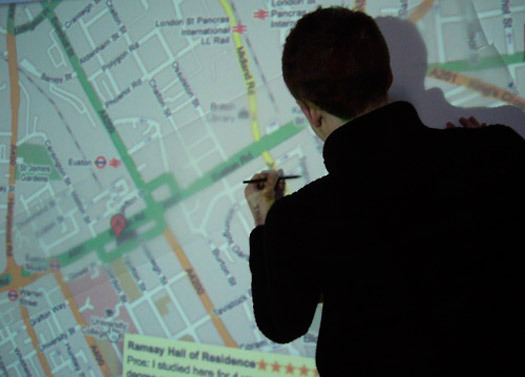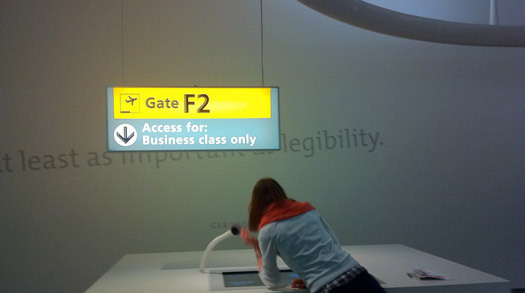
3D mapping exercise in the Information Environments studio
Much of design is informed by research of some sort; research, on the other hand, is almost never informed by design. Over the past several months, my students and I have built a curriculum centered around the idea that research and design are two sides of the same coin. We took it for granted that research can inform design; what took us by surprise was the great extent to which design can, in turn, enhance research.
On that very first day of class, we were all handed a complex, real-world design project on airport security — a topic none of us knew anything about (except as travelers).
My own background was in museums and technology, having designed installations, software and web sites, then spent the last seven years completing a PhD on the same subject. Now I was charged with running a new Masters program in “Information Environments” at University of the Arts London — with no prior teaching experience.
To be fair, I did willingly apply for the job. I had run a fair number of workshops and seminars over the past several years. And my PhD was, after all, from the Institute of Education, my work grounded solidly in research theory and methods.

Kevin Walker (at rear) with students at the Growing Knowledge exhibition at the British Library. Photo by Stephanie Lessmann
It turned out that most of my students were doing the Masters — an MRes, not an MA — for the same reason I had done the PhD: to ground their design practice in theory; to better understand their clients, customers and users through research; and to learn empirical methods in order to rigorously evaluate things and experiences, whether designed by themselves or by someone else.
We started with a strong foundation. Information Environments is the brainchild of Teal Triggs, a designer and researcher herself — typographer by training, expert in fanzines by choice. A transplanted Texan, she started IE as a way of tackling the future head-on. The physical world was quickly inhabiting the virtual; at the same time, thanks to sensors and ever-shrinking computers, the digital was quickly and quietly inserting itself into the real world. IE was founded to investigate precisely this proposition. More than just a platform for granting a Masters degree, it's become an entire research network with funded projects, industry partners, and indeed, PhDs. (If only it had been around seven years earlier when I was starting mine!)
My own experience fit in well, however. Thanks to my own degree from NYU's Interactive Telecommunications Program, I had learned to use those sensors and microcontrollers to bring spaces and things to life. Interestingly, they could be used for collecting research data as well as for serving up information — even simultaneously. And with falling prices, open source tools, and growing communities of developers, all of these tools were getting easier to use. Where I once had to solder components onto boards and write low-level code, my students could simply plug in a Kinect camera or an open-source Arduino board, and copy and paste snippets of code freely posted in an online forum.

IE student David Kopulos in a physical/digital mapping exercise

IE student David Kopulos' interactive mapmaking activity in a recent student exhibition. Photo by Daria Filatova

IE students construct a walk-in information visualization. Photo by Daria Filatova
Students everywhere are, of course, increasingly technology-savvy. After introductory sessions on Arduino and its software counterpart Processing, the students produced amazing projects for the practical unit of the course — a forest of hanging lamps made from brain-scan x-rays; an augmented-reality flashlight that turned one room into another; an interactive projection into mid-air that you had to “catch” on your hands and body, for starters. They also used technology for data collection. One student, for example, used a special camera to capture photos of his entire lived experience over a week, in five-minute intervals, and presented this in an interactive video mosaic.At the same time, it wasn't all high tech. Because we're located in the former London College of Printing, students took advantage of our letterpress studio and 3D workshop. They cast travel mileage in solid silver jewelry, plotted carbon miles in electro-luminescent wire, rendered biorhythms in laser-etched plexiglas, and so on: all of it grounded in (and subsequently providing the grounds for) deep research.
In laying a theoretical foundation for the course, we first deconstructed the very title. To unpack “information,” we went right back to Claude Shannon, whose 60-year-old theory for sending messages over noisy channels proved useful for embarking on our airport project. Later, we looked into cognitive psychology, to better understand how people perceive and process information. This meant distinguishing information from data, knowledge, and understanding. What is this “information society” we’re supposed to be living in, and when does it become a “knowledge society”? Social networking has spawned a new definition of knowledge: what does it mean when your “friends” are always with you, helping to define what you read, and do, and consume?
Facebook took all the theorists by surprise, upturning Google's model of personalized information and raising interesting questions about the powerful role social media play in personal selection. Social semiotics in general have proven useful for grounding our investigations, and we were fortunate to have Gunther Kress — a pioneer of this approach —nearby in London to assist. His approach to multimodal analysis was subsequently taken up by several students for their Masters projects.
Students also considered the notion of activity theory, with its emphasis on motivation and mediation. Originating in Russia and Scandinavia, it has taken hold among HCI researchers — but not, as yet, in the wider design community. Our team found it useful for focusing on how tools (both external and cognitive) help people accomplish goals within socially-contextualized activities (rather than as individuals) as a unit of analysis. They looked at “thingness” — undoubtedly a reaction to the pervasiveness of screen-based information, this approach embraces the handmade, the natural and the physical, but also includes the embedding of digital technologies into physical objects. (A recent article in the New York Times detailed how $30 Arduino boards were bringing artworks to life in museums and galleries. Noted NYU’s Tom Igoe: “Imagine when every piece in a museum has an Arduino built in that can see how people interact and look at the artwork.”) They considered crowdsourcing — the idea that participants across the Internet contribute to and collaborate with others across a wide spectrum of activity (a particularly interesting proposition as it so dramatically opposes the traditional model of the lone scientist or, for that matter, the lone designer). And they looked at the notion of “constructionism.” Developed by MIT’s Seymour Papert several decades ago, it means giving people the tools to help them learn, through actually making something. The idea is that building something physical helps to build, in turn, cognitive structures, a loosely scientific idea that has a great deal to do with the way people process and respond to real information.

IE student Daria Filatova encounters airport signage at the Design Museum in Ghent, Belgium. Photo by Stephanie Lessmann

IE student Stephanie Lessmann invited people to explore her own brain in a walk-in forest of x-ray lamps
We explored different approaches to the notion of objectivity. The “soft sciences,” such as ethnography, tend to acknowledge and embrace subjectivity on the part of the researcher. Hard sciences like physics either reject objectivity outright (think of “Schroedinger's cat” thought experiment, for instance, in which the mere act of observation affects the outcome of an experiment) or, like journalists, scientists try to avoid the issue by relying on other sources of evidence — empirical methods, for example, for data collection and analysis. Indeed, while not necessarily seen as worthy in academic circles, journalistic methods have long been perceived as accepted practice in design research: interviewing people, investigative research, writing it up in concise and coherent stories — this is one of the strongest ways designers come to know their users. Calling it journalism — even investigative journalism — instead of scenarios or user stories exposes critical issues to the budding designer-researcher: it introduces methods, helps to define motives and ethics, and reinforces the necessity for ruthless objectivity.
Which brings us back to design. Designers can help researchers develop better tools for data collection and analysis, informed in turn by research — for example, activity theory can help to think about and design tools to help people accomplish particular goals.
More important than tools, though, research desperately needs design expertise to better communicate its findings. We found this out first-hand when it came time to present the results of our airport project to industry and government officials. So accustomed were they to reading long, boring reports and documents that simply seeing research concisely and visually presented on nicely-designed posters was a revelation to them. Some of the students' work was immediately picked up for commercial development.
It was vindication that we were doing something right. More important to me was watching the students go from designers to researchers: in January they tended to approach projects with already sketched-out ideas in their heads; by June they were already formulating their own methodologies and handing in publication-quality research papers.
As designer-researchers, we can make our own tools for investigation. This is nothing new; think of science from Leonardo to the Large Hadron Collider. Or indeed, design research methods such as “cultural probes” developed by Bill Gaver, Tony Dunne and Elena Pacenti. There is an urgent need — and opportunity — for well-designed presentations of scientific data which go beyond screen-based eye candy, informed by research into cognition and perception, as well as conveying meaningful content.


Comments [1]
The second point regarding animating the real relates to the apparent assumption that electronic communications technologies are the best way in which design can make the world more inhabitable. In this case I think that the technophilia of Design is selling the possibility of design way to short. As Elaine Scarry has suggested, the act of making something as 'simple' as a chair is already a way in which the material world can be made more meaningful, intelligible, and livable. Perhaps we can see here that the design of this study has already set in place the limits of how design will be understood, meaning that despite the useful outcomes of the study, it could also not help but reinforce the implicit assumptions that designers make about design. I wouldn't want to suggest a 'limitless' understanding is a possible or desirable alternative, but I do think the relation between design and research warrants a some more critical attention.
10.12.11
07:42